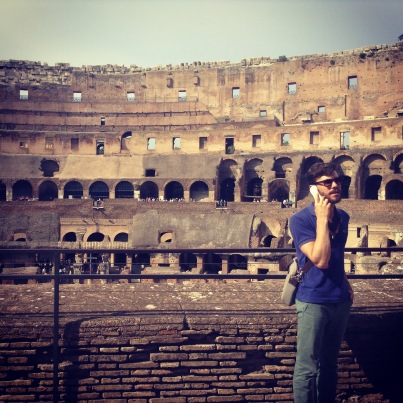
Transcription
AMPHITHEATRVM FLAVIVM TRIVMPHIS SPECTACVLIS[QVE][,] INSIGNE DIIS GENTIVM IMPIO CVLTV DICATVM MARTYRVM CRVORE AB IMPVRA SVPERSTITIONE EXPIATVM[,] NE FORTITVDINIS EORVM EXCIDERET MEMORIA[,] MONVMENTVM A CLEMENTE PONT[IFICE] X MAX[IMO] AN[NO] IVB[ILATIONIS] MDCLXXV PARIETINIS DEALBATIS DEPICTVM TEMPORVM INIVRIA DELETVM[;]
BENEDICTVS XIV PONT[IFEX] MAX[IMVS] MARMOREVM REDDI CVRAVIT AN[NO] IVB[ILATIONIS] MDCCL PONT[IFICATVS] X[;]
PIVS XI PONT[IFEX] MAX[IMVS][,] QVVM PARTEM MEDIAM ET MVNIENDAM CVRASSET[,] MEMORIAM RENOVAVIT ANNO MDCCCLII PONT[IFICATVS] VII[.]
Translation
The Flavian Amphitheatre, dedicated by impious worship to triumphal celebrations and spectacles, an honour to the gods of the people, has been expiated from impure superstition by the gore of martyrs; and, lest the memory of their fate should pass away, it has been established as a monument by Pope Clement X in the jubilee year of 1675, with the old ruined walls having been whitewashed, since what was depicted on them had been rubbed out by the injury of time;
Pope Benedict XIV took pains that the marble should be returned, in the jubilee year of 1750, and the tenth year of his pontificate;
Pope Pius XI, since the middle portion was also in need of building up, took pains to do so, and restored its memory in the year 1852, the seventh year of his pontificate.
Commentary
The mythic history of the Colosseum is replete with accounts of martyrdoms of Christians within its walls, and for this reason has been a site of pilgrimage for centuries. Pope St. Pius V (whose pontificate lasted from 1566-72) is reported to have encouraged pilgrims to gather sand from the arena which contained the blood of martyrs. Yet this interest in the Colosseum seems to have been a phenomenon originating in the Renaissance: there is virtually no evidence of a medieval tradition associating the martyrs with the Colosseum. And, even in the Renaissance, this pious association was apparently sometimes met with scepticism or even disinterest. Sixtus V (1585-90), for example, proposed that the Colosseum be converted into a wool factory, but died before this plan could be put in motion. And in 1671, the Colosseum was even designated as a space for bullfights.
However this attitude changed gradually, helped by a popular guide for pilgrims to Rome by a writer called Martinelli. In 1675, Pope Clement X ordered that the exterior arcades of the Colosseum be closed, and that the interior space be converted into a sanctuary.
The Latin here apparently contains a reference to an interesting practice of ancient Rome: the Triumphus, a celebratory procession made by victorious generals from the Campus Martius to the Temple of Jupiter Optimus Maximus. In imperial times, this procession was altered, so that it was made from the Campus Martius to the Temple of Mars Ultor.
The purpose of the triumphalis was, bluntly put, to show off things and people captured in military campaigns. Hence Cicero asks “Quid tandem iste currus? quid vincti ante currem duces? quid simulacra oppidorum? quid aurum?…” (“What, finally, is this chariot? what captured things do you lead in front of it? what images of towns? what gold?…”; Oratio in Pisonem 25.60); and Suetonius reports that “Gallos Caesar in triumphum ducit” (“Caesar led captive Gauls in the triumphal procession; Caes. 80).
Another noteworthly Latin word here is Cultus, from which we derive the English word Cult, but also Cultivation. Augustine says that Cultus is “deitati debitus” (i.e. worship “owed to the Divinity”), but points out in City of God X.1 that
[…] Si tantummodo cultus ipse dicatur, non soli Deo deberi uidetur. Dicimur enim colere etiam homines, quos honorifica uel recordatione uel praesentia frequentamus […]Nam ex hoc uerbo et agricolae et coloni et incolae uocantur, et ipsos deos non ob aliud appellant caelicolas, nisi quod caelum colant, non utique uenerando, sed inhabitando, tamquam caeli quosdam colonos.
That is,
…if Cultus alone is what is said, it does not seem to be owed to God alone. For we are said also to honour (colere) other people, that is, those whose honour, either by memory or by presence we celebrate […] for, from this word, we derive the words Farmer (agricola), Husbandman (colonus), and Inhabitant (incola), and the gods themselves are called Heaven dwellers (caelicolas) for no other reason than that they live in the heavens — at any rate, they are so called not because they worship the heavens, but because they live in them as, so to speak, inhabitants of heaven.
Further Reading/Sources
The Catholic Encyclopedia entry on the Colosseum.
Augustine’s City of God on New Advent, translated by Marcus Dods.
Augustine’s works (Latin), including De Civitate Dei, via The Latin Library.
41.890210
12.492231





